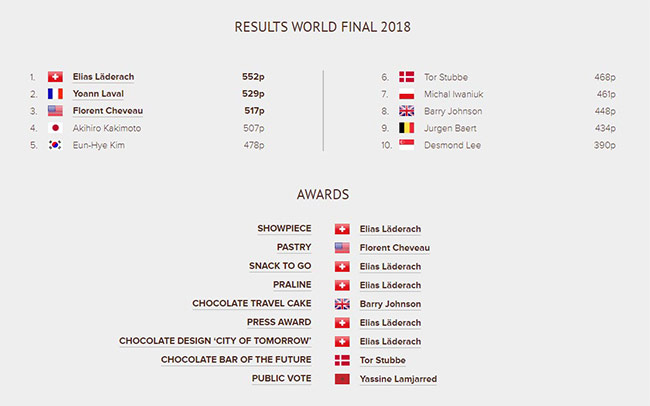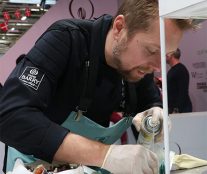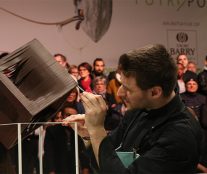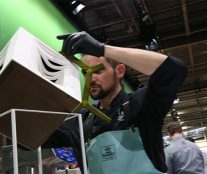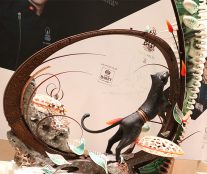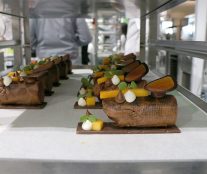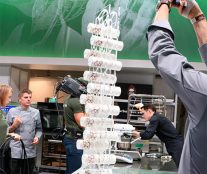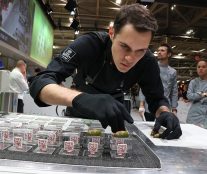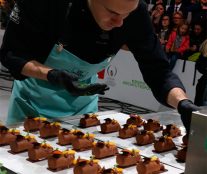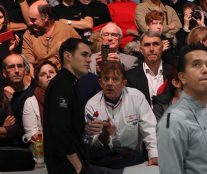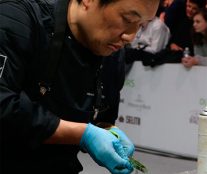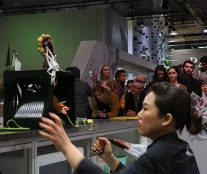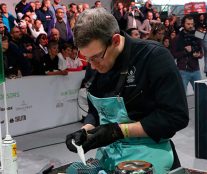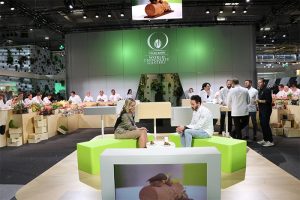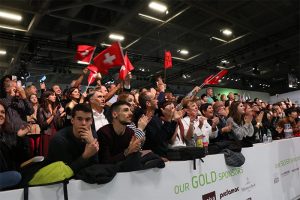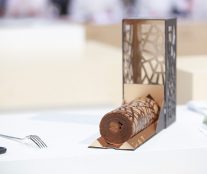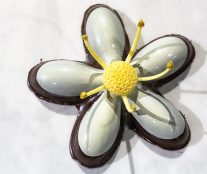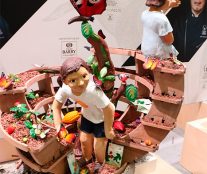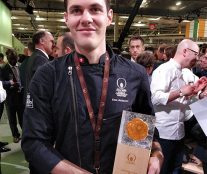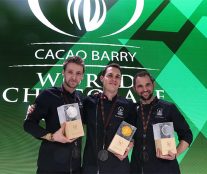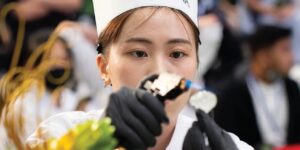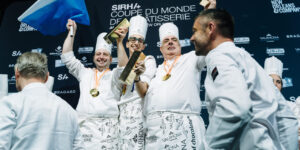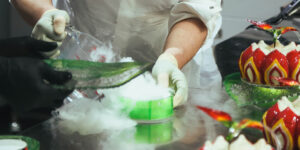The show must go on! The Swiss chef Elias Läderach wins World Chocolate Masters 2018
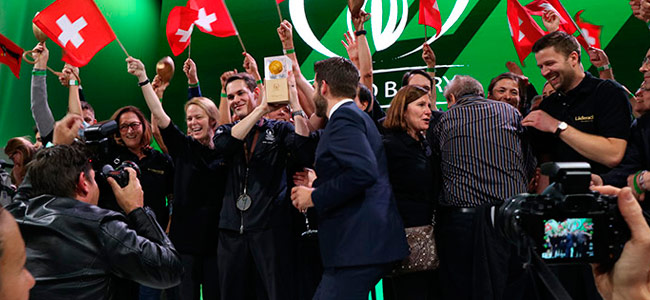
Author:
Jaume CotCacao Barry gave another twist to its impressive and spectacular display of means for the celebration of the World Chocolate Masters. If the television format retransmitted live had become the norm in recent editions, if the knockout rounds within the grand final, increasing tension and suspense to the development of the competition, assaulted as a novelty in the previous edition of 2015, now both factors are even more interwoven, adopting the style of a television talent show in which at the end of each stage there was reason for disappointment or glory according to the luck of each of the participants. Outside of the format, the competition proves once again that it is capable of bringing true professional giants who are able to manipulate chocolate with a level of extraordinary technical perfection, both in what refers to the assembly of artistic pieces, as in the deployment of a chocolate buffet, bonbons, and cakes that take into account the latest consumer trends (allergens,local products, etc.).
Within the limits of creativity
The theme proposed by Cacao Barry for this edition, “Futropolis”, was to serve as an invitation to participants to use their work as a reflection on the role of chocolate in the future.They had to blow their imaginations away and surprise the jury with their work, as Frank Haasnoot himself, president of the jury, said, not so much surprising but impressing within what one already expects to find in a competition of these characteristics. And this is one of the keys to the unequal success of each one of the contestants. Those who interpreted the demands of the competition in a riskier way, with unpublished and personal work, actually surprised the jury, but they also found a limit to their possibilities partly due to a lack of acceptance of those surprises. This was the case, for example, of the jovial Tor Stubbe, from Denmark, who marked a personal path in both the chosen formats and in the search for local flavors and products linked to cocoa, but treated from the workshop itself, getting for example a cocoa kombucha or edible cocoa fibers among others, in addition to unusual flavors such as buckwheat and miso. Being one of the two repeaters of the competition- the other was the Japanese chef – he finished in sixth position, going down a position regarding his performance in the previous edition.
Freedom in formats, restrain in flavors
On the contrary, the most openly conservative approaches were reflected in the range of flavors offered, not in the formats, of the American chef Florent Cheveau, and of the French chef Yoann Laval, giving them the third and second place respectively, but not quite reaching the top of the podium. Nobody like the Swiss chef, Elias Laderach, to take technical perfection and versatility in each of his creations to the very top, especially on the artistic side, where in addition to the lightness and dynamism of their compositions, the brilliance and technical perfection that reigned in each and every one of their parts amazed the jury. For him, most of the prizes were awarded in each of the contest categories, and that his proposed as an objective to reduce the average sweetness of his creations up to 60% in some cases. As a reward, he obtained a total of 559 points, a factor that allowed him to accumulate a small but comfortable advantage of more than 20 points with respect to his closest opponent, the French chef Yoann Laval.
Japan, Korea and the United Kingdom
Worth mentioning were also the creations of the Japanese chef Akihiro Kakimoto, maybe less surprising in the artistic part, but very elaborate and personal in the tasting. His temper and cold blood, which was probably obtained in his previous participation in 2013, lead him to once again come in fourth place, the same position he obtained the first time. Much more emotional and unexpected was the fifth place for the Korean chef Eun-Hye Kim, who developed very solid conceptual work around the cocoa bean, from its plantation to the possibilities of it surviving the climate in the future, deploying a game of flavors as personal as they were finely executed. She was the first and only woman among the top ten who classified, in an edition that continues to show the lack of women prepared to have possibilities in this type of competitions – there were only two more women in the total of 20 finalists.
Few more relevant data to add. We are also perhaps with the exceptional work English chef Barry Johnson, with whom this country is accustoming us to his presence in first positions in great championships. This Englishman took the prize for the best travel cake and got a not inconsiderable eighth place. Nothing negligible especially if, according to one of his coaches, Martin Chiffers,who told us that he had designed and prepared the majority of his work for the grand finale in just one month.
The (tv) show must go on
For three days, the Salon du Chocolat in Paris hosted a first level competition that little or nothing has to envy other international pastry competitions. A true chocolate “champions league” that was also broadcast live through social networks – for example our Facebook page– with a device television performance at the height of a first level event. Day after day, the different tests, starting with the travel cake and the artistic chocolate piece, after which the scores of all the participants was publicly announced. Little was going to change from that first classification, which left France and Switzerland tied, but that had already placed Japan, the United States, Denmark, and Korea at the top.
The most frantic day of the three, the second day, forced the 20 contestants, divided into two rounds of 10, to make the Or Noir bar, the chocolate snack, and the molded bonbon. Another heart-stopping moment awaited us at the closing, where in a rigorous live television broadcast, the finalists went up to the stage in groups of three to four contestants to separate who had reached the grand finale of the third day, compared to the 10 who went home.
The small chocolate piece, built on a box offered by the organization, and the fresh pastry product, completed the assortment of creations made. Although all the betting pools pointed to Switzerland and France, especially those of the juries with whom we had occasion to speak, nobody knew with certainty which of the two candidates would end up winning, and more after the apparent mistake that that the Swiss candidate’s choux paste had in his Fresh Pâtisserie (see above). But Elias Läderach turned his mistake in a virtue, explaining to the jurors that the imperfect end of his choux paste cylinder emulated the uncertainties of the future, an irregularity that more than one juror loved and helped him overcome what ended up being his most significant setback on a good note.
The future of ‘futropolis’
The feeling that this new edition of World Chocolate Masters gives us is intense.
It shows without a doubt that it deserves to be treated as one of the great dates – the Biggest perhaps – in the competitive sector worldwide. A group of 20 lucky people have had the opportunity to become the stars of the sector for three days. Glittering stars that shine before the eyes of an extraordinary jury formed by the ambassadors that the Cacao Barry brand has all over the world, and also presided over by the aforementioned Frank Haasnoot (champion of 2011) in the company of Cédric Grolet and Naomi Mizuno.
It is worth wondering what this might hold for a competition of this magnitude in the future. It should wisely manage the great success to date and try not to tilt the balance too much towards either end. For example, the show just for the show, that would subtract professional interest to the competition. You also have to ask yourself if an event like this should be the one that arouses more interest in a trade such as the fine artisan chocolate sector, which maybe needs more relaxed scenarios that allow more attention to technical aspects, use of new ingredients, new consumer trends … elements that do not always match with the spotlights, the make-up, and the drum rolls. The day after Futropolis is here, and we are sure it will continue to get our attention. Let’s hope it’s worth it!
